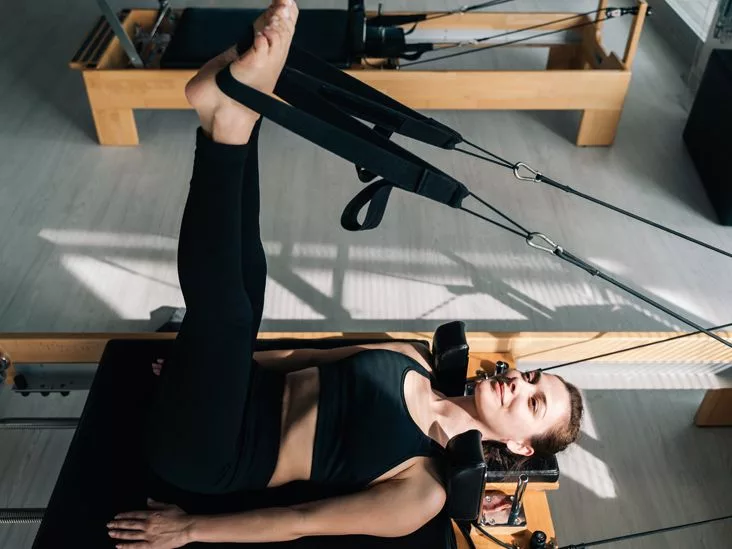Quick answer: Reformer Pilates is a low‑impact, spring‑resisted workout that builds core power, improves posture and can be adapted for every fitness level. Knowing the real benefits, potential risks and beginner‑friendly moves lets you decide if this equipment‑based Pilates style fits your goals.
What Is Reformer
How does a Reformer work?
The Reformer is built around a sliding carriage that glides on rails inside a sturdy frame. Springs attached to the carriage provide adjustable resistance, while a foot‑bar, shoulder blocks and long straps let you pull, push, lift or stretch in a smooth, controlled way. As you move the carriage, the springs either assist you (making the exercise easier) or add challenge (making it harder). This simple mechanic creates a full‑body workout that feels like a dance between force and support.
Key components and terminology
Understanding the parts makes the machine less intimidating:
- Springs: Light, medium or heavy – you set the tension by pulling a knob or inserting a pin.
- Foot‑bar: Adjustable bar at the end of the frame; you place feet or hands here for many moves.
- Shoulder blocks: Cushioned pads that keep the carriage stable and protect your shoulders.
- Straps & handles: Long cords with loops for hands or feet, allowing you to work in supine, prone or standing positions.
- Carriage: The moving platform you lie or sit on; its glide is what the springs resist.
Reformer vs. Mat Pilates
| Aspect | Mat Pilates | Reformer Pilates |
|---|---|---|
| Equipment | Mat, small props (ball, ring) | Reformer machine – springs, carriage, foot‑bar |
| Resistance | Body weight, limited props | Adjustable spring tension for precise load |
| Movement range | Floor‑based, static | Dynamic gliding, multi‑plane motions |
| Joint impact | Low‑impact, but can stress wrists/shoulders | Supports joints; springs absorb shock |
| Learning curve | Easy for beginners | Initial guidance helpful; quick progression |
According to Pilates.com, the Reformer’s adjustable resistance lets you move from gentle rehab to high‑intensity conditioning without changing equipment.
Who Can Benefit
Fitness levels – from beginners to athletes
Whether you’ve never set foot on a Pilates mat or you’re a marathon runner looking for stronger glutes, the Reformer adapts. Studios often group participants by spring tension, so a senior can use a single light spring while a competitive athlete stacks several heavy springs for a challenging circuit.
Rehab & injury prevention
Physiotherapists love the Reformer because it offers support while still demanding muscle activation. At Bend + Mend, clinicians use the machine to guide patients through low‑impact core work after back surgery, gradually increasing tension as strength returns.
Special populations
Pregnant and post‑natal clients benefit from the machine’s ability to off‑load the spine while still strengthening the pelvic floor. People with neurological conditions (e.g., cerebral palsy) can receive gentle, assisted movements thanks to the carriage’s smooth glide. Even the National Disability Insurance Scheme (NDIS) incorporates Reformer classes for functional mobility.
Key Benefits
Enhanced core strength & spinal stability
The springs force you to engage deep abdominal muscles (the transverse abdominis) before every push or pull. Over time, that hidden core becomes a solid “powerhouse” that supports the spine, reduces lower‑back pain and improves everyday posture.
Improved flexibility & range of motion
Because the carriage can move in any direction, you can lengthen muscles under gentle tension—a perfect antidote to tight hips or hamstrings. The “Long Spine Massage” exercise, for example, stretches the entire posterior chain while the springs support the lower back.
Full‑body conditioning
From arm presses on the foot‑bar to leg curls in the straps, a well‑rounded Reformer class hits every major muscle group. The integrated nature of the movements means you’re often engaging the core, glutes, hamstrings and shoulders simultaneously, making each minute count.
Low‑impact cardio & calorie burn
A 45‑minute Reformer session typically burns 200‑300 calories, depending on spring tension and intensity. The constant, rhythmic motion also raises heart rate without the pounding associated with running or jumping.
Mind‑body connection & stress relief
Breath is woven into every move; you inhale to prepare, exhale to execute. This focus on diaphragmatic breathing calms the nervous system, helping you unwind after a hectic day.
Risks & contraindications
While generally safe, the Reformer can be risky if you:
- Have uncontrolled hypertension or recent cardiac events.
- Are in the acute phase of a fracture or severe joint instability.
- Ignore pain signals—stop immediately if you feel sharp discomfort.
Always discuss your health history with a certified instructor or physiotherapist before starting.
Top Exercises
Beginner fundamentals
- Foot‑bar foot‑stretch: Lying supine, place feet on the bar, press out and pull back, focusing on breath and alignment.
- Supine arm work: With light springs, push the handles overhead while keeping the core steady.
- Kneeling lunge: One foot on the carriage, one on the floor; the springs assist the lunge, protecting the knee.
Intermediate challenge moves
- Teaser: A classic core‑intensive move that rolls the carriage up while lifting the torso.
- Elephant: Standing, hands on the foot‑bar, hips hinged back—great for hamstring flexibility.
- Long spine massage: A full‑body stretch that promotes spinal articulation.
Advanced power moves
- Jackknife: From a supine position, lift the hips high, then roll the carriage overhead.
- Side‑lying leg series: Engage the outer thigh while the carriage glides laterally.
- Standing roll‑up: Combines balance, core control and shoulder stability.
Reformer for cardio
Try a HIIT circuit: 30 seconds rapid foot‑bar pushes, 15 seconds rest, repeat for four moves (push‑ups, mountain‑climbers on straps, seated rowing, and squat‑to‑press). The spring resistance makes the heart pump faster while still being joint‑friendly.
Rehab‑focused exercises
- Pelvic tilt on carriage: Small spring, gentle cradle, perfect for low‑back rehab.
- Shoulder brace rows: Light springs, straps around the forearms, encouraging scapular stability without strain.
Quick reference cheat‑sheet
| Exercise | Target Muscle | Spring Setting | Modification |
|---|---|---|---|
| Foot‑bar stretch | Quads & calves | Light‑medium | Use a single spring or place a towel under the feet |
| Teaser | Core & hip flexors | Medium | Place a pillow under the back for extra support |
| Jackknife | Core & glutes | Medium‑heavy | Reduce spring tension, keep knees bent |
Choosing a Reformer Safely
Buying vs. renting
If you love the feel of the carriage and have space, buying a home unit (typically $2,000‑$5,000) can be a long‑term investment. Renting a studio carriage costs $30‑$50 per class and lets you test different models before committing. Brands like Fluidform even bundle digital challenges with the purchase for added motivation.
Studio vs. home setup
Studios provide professional guidance, varied spring sets and a community vibe. At home, you need at least an 8 ft × 6 ft clear area, a non‑slippery floor, and a wall‑mounted safety strap if you plan on advanced moves.
Setting the right spring tension
Think of spring tension like a bike gear: light springs for cruising (rehab or beginners), heavier springs for hill climbing (strength). A simple rule—if you can’t control the carriage’s return, the spring is too heavy.
Common safety mistakes
- Locking the foot‑bar in a position that forces the knees outward.
- Neglecting shoulder blocks, leading to shoulder strain.
- Using springs that are frayed or missing pins.
Maintenance & warranty
Inspect springs monthly; replace any that show cracks. Wipe the rails with a damp cloth after each class to avoid dust buildup. Most reputable manufacturers offer a 2‑year warranty on frames and springs—keep your receipt!
Professional guidance
The first few sessions should be with a certified Pilates instructor or physiotherapist. They’ll assess your movement patterns, set appropriate spring tension, and teach you cueing so you won’t develop bad habits.
Real World Stories
Post‑surgical knee rehab
Sarah, 42, recovered from ACL reconstruction. Her physiotherapist introduced a gentle Reformer program focusing on controlled leg extensions and hip bridges. Within six weeks, Sarah reported a 30 % reduction in swelling and could walk stairs without pain.
Desk‑worker back‑pain relief
Mark, a software developer, spent 10 hours a week hunched over a laptop. After joining a weekly Reformer class at a local studio, his chronic lower‑back ache faded. He credits the “pelvic tilt on carriage” and core‑stabilizing moves for the improvement.
Competitive runner performance boost
Emily, a 28‑year‑old marathoner, added Reformer strength circuits to her routine. Over a 12‑week period, her stride length increased by 8 %, and she shaved 5 minutes off her personal best. The springs gave her glutes the extra activation she needed for powerful push‑offs.
Bottom Line – Should You Try Reformer Pilates?
Below is a quick snapshot to help you decide:
| Pros | Cons |
|---|---|
| Low‑impact, joint‑friendly | Initial cost or class fees can be higher than mat‑only options |
| Customizable resistance for all levels | Learning curve – best with professional guidance |
| Full‑body workout in less time | Requires dedicated space at home |
| Excellent for rehab & injury prevention | Potential risk if springs are mis‑set or equipment is damaged |
If you’re looking for a balanced blend of strength, flexibility and mindful movement—without the pounding of high‑impact cardio—the Reformer can be a game‑changer. Start with a beginner‑friendly class, test a few spring settings, and listen to your body. You might find yourself falling in love with the smooth glide and the way every session leaves you feeling stronger, taller and more centered.
Ready to give it a try? Book a complimentary introductory session at a local studio, or explore a home‑Reformer package if you have the space. Your body (and mind) will thank you.


















Leave a Reply
You must be logged in to post a comment.